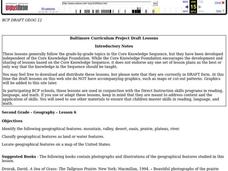EngageNY
General Pyramids and Cones and Their Cross-Sections
Are pyramids and cones similar in definition to prisms and cylinders? By examining the definitions, pupils determine that pyramids and cones are subsets of general cones. Working in groups, they continue to investigate the relationships...
EngageNY
Modeling an Invasive Species Population
Context makes everything better! Groups use real data to create models and make predictions. Classmates compare an exponential model to a linear model, then consider the real-life implications.
EngageNY
Which Real Number Functions Define a Linear Transformation?
Not all linear functions are linear transformations, only those that go through the origin. The third lesson in the 32-part unit proves that linear transformations are of the form f(x) = ax. The lesson plan takes another look at examples...
EngageNY
The Geometric Effect of Some Complex Arithmetic 1
Translating complex numbers is as simple as adding 1, 2, 3. In the ninth lesson in a 32-part series, the class takes a deeper look at the geometric effect of adding and subtracting complex numbers. The resource leads pupils into what it...
EngageNY
Projecting a 3-D Object onto a 2-D Plane
Teach how graphic designers can use mathematics to represent three-dimensional movement on a two-dimensional television surface. Pupils use matrices, vectors, and transformations to model rotational movement. Their exploration involves...
EngageNY
Applications of Congruence in Terms of Rigid Motions
Corresponding parts, congruent parts, congruent corresponding parts—what does it all mean? The resource challenges pupils to identify corresponding parts for pairs of figures. It uses examples of figures that undergo rigid...
Curated OER
Essential Elements of Habitat
First graders compare their local area with the Belize landscape. They construct maps of the school area, adding descriptive information. They write haiku poems about their favorite outside places.
Curated OER
Mummies Made in Egypt
Pupils use maps to locate information on Egypt, then create their own maps to display knowledge gained from the lesson and Web sites. They recognize, create, and describe the pyramid's geometric shape in three-dimensional forms.
Curated OER
New Pen at the Zoo
Students create two drawings for a new animal pen design at the zoo. They must draw the ideas keeping the amount of material available in mind. They compare and contrast their two designs and write how they are similar in perimeter and...
Curated OER
Space and Shape in Geometry:
Young scholars are asked to visualize three-dimensional figures and apply this visualization to problem solving.
Curated OER
Geography Game
Second graders, in groups, selects a letter as a starting point and announces the direction in which he intends to move on a map. The team that closes a square takes possession of the square and marks it with their symbol.
Curated OER
Africa
Students complete various activities related to the continent of Africa. They label and color a map of Africa, sing the Continent Song, view pictures and discuss animals of Africa, listen to the book "Bill and Pete Go Down the Nile,"...
Curated OER
Guess My Shape
Students describe shapes to other students who have to guess that shape. In this shape lesson plan, students describe shape attributes to other students. Then those other students have to guess the shape that is being described to them....
Curated OER
Measurement Benchmarks and Conversions
Students explore the concept of measurement. For this measurement lesson, students determine appropriate units of measure for objects in the classroom. Students discuss the importance of measuring objects with the same unit of measure.
Curated OER
How to Study For a Test
Students discuss test taking strategies. In this studying lesson, students look in their Test Packet to find which questions they answered incorrectly and why they got them wrong. They create a manual to prepare for a successful test.
Curated OER
Coordinates
Students identify and label the coordinate planes by the four different quadrants. In this geometry lesson, students plot an ordered pair correctly. They identify and differentiate between rational and irrational numbers.
Curated OER
Ratio Relationships
Students solve for the different ratio and proportion of a problem. For this geometry lesson, students show their knowledge of how to solve proportional relationships. They convert between percent, decimals and fractions.
Curated OER
Introduction to Biometrics
Students use the internet to research how biometrics is being used in the real world today. They work together to research hand geometry applications. They share their findings with the class.
Curated OER
Geography
Second graders study and review geographical terms for features. They classify those features and locate them on a map. They review geographical features of Tall Tales.
Curated OER
American Civilization
First graders research and examine various events during the American Revolution. They locate the thirteen colonies on a map, create Boston Tea Party boats, and construct Paul Revere paper lanterns.
Curated OER
Basic Geometry Ideas and Angle Measurement
Seventh graders explore the concept of basic geometry. For this basic geometry lesson, 7th graders identify the correct picture for a given vocabulary word such as midpoint, line, ray, or parallel lines. Students discuss examples of...
Curated OER
Measurement
First graders participate in various activities dealing with measurement, length, volume, and temperature. They identify the need for standard units of measure, sort and classify objects, measure distances, and use a thermometer.
Curated OER
Explora-Pond: 1st Grade Shore Count
First graders experience addition through the exploration of a virtual pond. They categorize the various plants around the pond, count the number of various types of plants on the pond shore, and calculate the number of shrubs.
Curated OER
Knowing the Essential Elements of a Habitat
First graders compare their environment with that of Belize by researching via the internet on the sites provided. Students participate in various activities/centers utilizing the information they discovered.

























